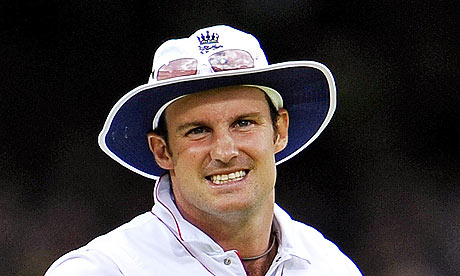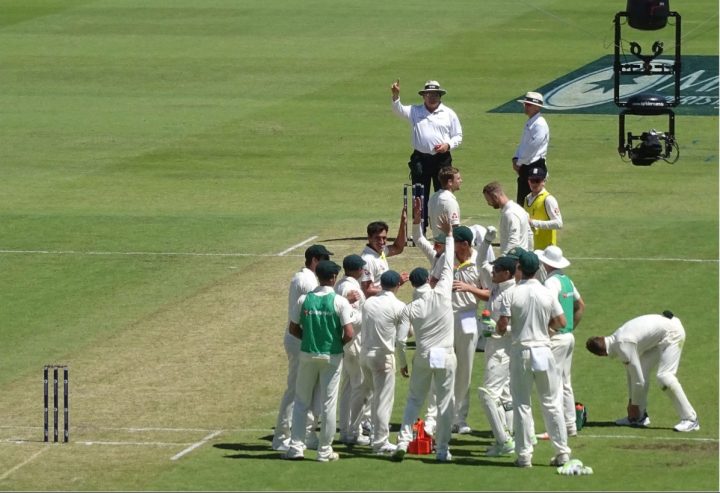
When the players went off for bad light yesterday Sky interviewed Steven Finn, England’s Ashes debutant and prime candidate to snap in half at any time – when he took that low caught and bowled in the afternoon session, millions of viewers instinctively lunged for the sticky tape.
It had been a good day for Finn. Despite a shaky start, he bowled with good purpose and picked up two wickets. However, his mood was one of frustration as England were keen to bowl with the new ball in fading light.
Whether it was deliberate or a slip of the tongue, Finn also revealed England’s strategy for this Ashes series (or any other series for that matter): ‘These are good pitches in Australia so there’s no point in chasing wickets. We have to sit in the game, be patient, and wait for the batsman to make an error’.
This statement may seem innocuous, but think about it. Which England bowlers have had the most success down under? Then consider the brand of cricket that Australian teams usually play – not the hesitant fare we witnessed yesterday but the variety Steve Waugh’s side used to play. You might even put Finn’s words into the context of our decision to pick four bowlers.
Identify the problem? Cricket is a game that rewards those who makes things happen. Darren Gough was brilliant in Australia, whereas the likes of Angus Fraser struggled. The great Aussie teams played ultra positive attacking cricket that bullied opponents. Did they ‘sit in the game’ and hope the batsmen threw it away?
And what if the batsmen don’t surrender their wickets in a fit of absentmindedness? If you’re relying on the likes of Michael Hussey to make an error, you’re going to be waiting an awful long time.
My beef, of course, is that England are being too conservative. Andrew Strauss and Andy Flower are good leaders, but they’re both uber cautious. At 143-5 England were on top yesterday. But our bowlers tired in the evening session and their speeds dropped accordingly. The mindset also became more negative and we failed to take a wicket.
Instead of having a fifth bowler that could get stuck in, Strauss was forced to throw the ball to the embarrassingly benign Paul Collingwood. Meanwhile, the shoulders of the frontline seamers dropped and they went into standby mode – waiting for something to happen. This is a grove, or rut, we fall into all too comfortably.
Did Peter Siddle sit back and conserve energy on the first day? Absolutely not. He grabbed the game by the scruff of the neck and seized the moment.
In 2005 we beat the Aussies by fighting fire with fire. This time our strategy revolves around hoping the Aussies beat themselves. I hope it works, I really do – but I don’t like it. The greatest cricketers we’ve had in the last twenty five years were Ian Botham and Andrew Flintoff, not Chris Tavare and Derek Pringle.
James Morgan









Depends on how you interpret his comments. He may just have meant what most players advise – that on flat, hard pitches when the ball won’t do much, you can’t bowl the way you do in England, expecting the ball to do everything for you. Instead, you’ve got to keep putting the ball in the right area and apply steady pressure.
Isn’t that actually what Glen McGrath did all his career? He never did that much with the ball, and he wasn’t very fast, but he metronomically put the ball on the spot, over after over, got a little nip sometimes, and let the batsmen fail under the pressure.
McGrath was also very aggressive and had a good bouncer in this youth. He was always trying to get the batsman out, rather than just make a mistake. You can be both accurate and attacking.
Oviously, Finn could just be resorting to cliche by saying ‘we’re sitting in’ but the article tries to place his comments in a broader perspective – taking into account England’s general tactical/selection approach. I suppose what I’m trying to say is that England often revert to the South African approach of ‘we’ll try not to lose first, and then try to win’, rather than the tradition Aussie style of playing positive cricket from the start.
Strauss / Flower could point out that the Cricketboks actually managed to win in Australia recently – but how many times has the more aggressive team win won down under?
James, I agree with THA here. I think you are taking a different interpretation. McGrath was aggressive but aggressive through defence. He stopped the runs by bowling in good areas, creating pressure and waiting for the batsmen to make a mistake. England collapse was started by the Aussies drying up the runs and then pushing hard once a break through had been achieved. Sitting in.
Warne would always attack but there is no player like him at the Gabba!
That’s not actually that traditional. We’ve come to think of it as being classically Australian, but you don’t have to look back that far to see a very different attitude. Allan Border’s Australian side was uber aggressive, but they were also extremely cautious and their primary concern was not losing. The success of the modern Australian side was based on the fundamental principal of never losing, and winning when the opportunity arose. Trying to win every game was a tactic begun under Tubby, and fully adopted under Tugga. The difference was that by the time Tugga became captain Australia was so dominant that they could attack relentlessly without serious fear of losing. That’s not a luxury either side in this series has.
McGrath’s bouncer could be used to prove the opposite view. When he was targetting Atherton, for instance, he would repeatedly bowl bouncers in the right area, and just let Atherton’s natural inclination get him out on the hook.
The vast bulk of his dismissals, though, were rather more mundane. He put the ball in the channel over and over, and let the batsmen try to attacking off a good line and length. His patience and commitment was greater than the batting side’s.
I agree largely that attacking is the best option, but would also wonder whether we have the attack for relentless offensive and whether these are the pitches which best suit that sort of assault.
Worth noting, of course, that India’s strategy is broadly to bat the opposition into submission, often scoring very slowly over several days, and then hoping the oppo give in to their bowlers. Their pitches, likewise, favour a more mundane approach, and blunt the blade of the more attacking teams.
There are obviously times in a match when nothing is happening and bowlers have to be patient, but I feel that England take this too far. Team selection reflects this over-cautious attitude. I don’t want this to become another 4 bowlers verus 5 debate, but I find it exasperating when I see the England seamers bowling within themselves, and ‘sitting in’ at 80 mph when we all know that Finn and Broad are capable of bowling much faster and shaking up the Aussie lineup. The team selection however (4 bowlers with no viable supporting options like Watson/North etc) prevents us from attacking 100% other than in the early part of sessions when the bowlers are fresh.
This Aussie batting line-up is vulnerable, yet our quicks have to conserve their energy and cannot bend their backs when the team really needs someone to take the game to the opposition – and press home an advantage. In order to do this, we are almost entirely reliant on Swann, who didn’t bowl well yesterday.
When I met Flintoff, these were his sentiments – and his explanation of why we won in 2005. He also revealed how conscious guys like Anderson were about their workload, and the need to conserve energy. Their state of mind therefore becomes one of endurance and ‘hanging in there’ rather than attacking. We all know that seamers who bowl 80-85 mph are two-a-penny in country cricket. You need that extra nip in test cricket to trouble the batsmen. England have these bowlers, and the ability to attack Australia, but they are physically hamstrung by their workload and the mental approach passed down to the players from captain and coach.
If Michael Vaughan, a superior tactician to Strauss, was captain now, what would his attitude and approach be. And what team would he want to take the field with?!
That’s a legitimate view, with a lot of merit in these circumstances. One problem is that the batsman to have lost out in this Test would probably have been Bell, and he looked like our strongest player. We could now be defending 180 with five bowlers, instead of 260 with four. There’s a price for everything.
Ah, but Bell is probably our best batsman right now, especially after his huge ton in Hobart. I doubt he wouldn’t missed out. To suit my argument, I’ll say that Strauss would’ve been the one to miss out, as he got a third ball duck! (just joking of course)
It’s impossible to decide the 4th/5th bowler debate by statistics. The 6th batsman got 70-odd in the current game, but the Hussey/Haddin partnership is currently worth more than that. If we had an extra bowler (and the current seamers were able to bend their backs a bit) perhaps they wouldn’t have put on any runs at all. Hussey nicked his first ball and it didn’t quite carry to slip. If the seamers had been bowling faster, then maybe it would have carried! Any way, I digress. The article is mainly about mental approach (of which team selection is only a part).
I understand the counter-arguments of course. They are all valid. I also appreciate that Andy Flower knows a thing or two about international cricket!